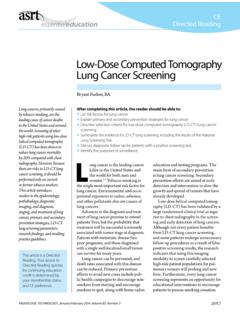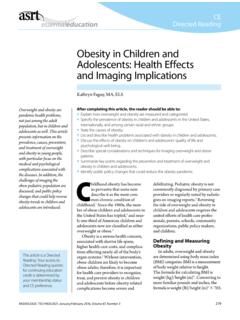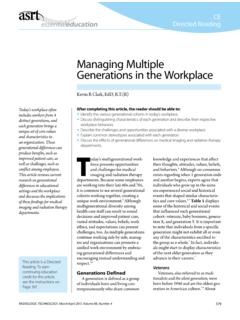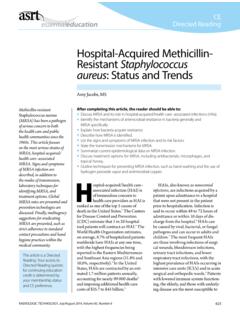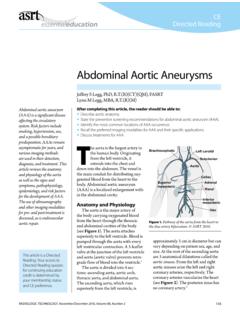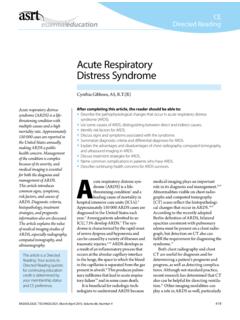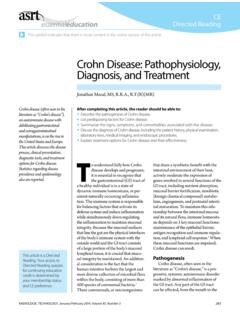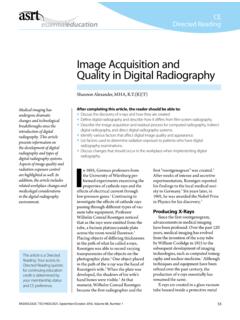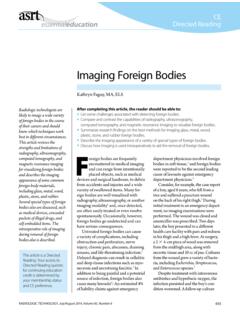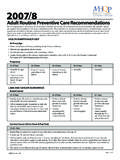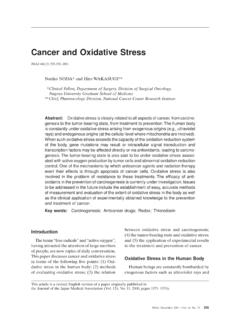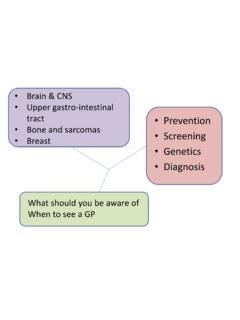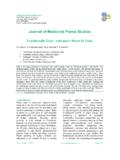Transcription of Advancements in Molecular Breast Imaging
1 523 MRADIOLOGIC TECHNOLOGY, May/June 2014, Volume 85, Number 5 CEDirected ReadingThis article is a Directed Reading. Your access to Directed Reading quizzes for continuing education credit is determined by your membership status and CE preference. Breast cancer is the second most deadly type of cancer affecting women, accounting for nearly 1 in 3 cancers in women. An esti-mated 2 830 000 women are living with Breast cancer in the United The mortality rate from Breast cancer has decreased, largely because of increased awareness and Advancements in medi-cal Imaging technology such as molecu-lar Breast Imaging (MBI) that aid in early detection (see Figure 1).2,3 A lthough Breast cancer is com-mon among women, the disease does not discriminate between the sexes. Approximately 1% of all new Breast cancer cases each year occur in Molecular Breast Imaging , sometimes referred to as Breast -specific gamma Imaging (BSGI), is a nuclear medicine procedure specifically Breast scin-tigraphy that is cost-effective and improves lesion detection, especially in dense breasts.
2 A nuclear medicine tech-nologist or physician injects the patient with technetium Tc 99m sestamibi, a radiopharmaceutical that accumulates in tumor cells more than in other body cells because of tumor cells high meta-bolic activity. cancer cells are highly metabolic with a higher cytoplasmic mitochondrial density, which causes them to uptake the majority of the trac-ing agent. W hen the radioactive tracers attach to cells with increased metabolic activity, the results show a highlighted area on the nuclear medicine mammography unit first was used in the United States in 1969, and although the technology remains the most important tool used for Breast cancer detection, the risk of radiation-induced Breast cancer from mammogra-phy still is As with mammog-raphy and all diagnostic medical Imaging examinations that use radiation, physi-cians must weigh the risks of radiation dose with the benefits a test will provide when scheduling an MBI procedure.
3 In applying the A LAR A (as low as reasonably achievable) principle, radio-logic technologists are tasked with keep-ing their patients radiation dose as low as possible while maintaining diagnostic After completing this article, the reader should be able to: Explain Breast anatomy and the significance of Breast composition. List genetic factors related to Breast cancer risk. Discuss traditional Breast Imaging modalities. Explain practice guidelines, clinical indications, and contraindications for Molecular Breast Imaging (MBI). Describe the equipment and procedures used for MBI. Discuss the advantages of MBI vs other Breast Imaging modalities. Breast cancer is the most common cancer in women, but with early detection, it is a treatable disease. Mammography has long been the medical Imaging standard for Breast cancer screening , with other Breast Imaging modalities used as adjunct procedures to support diagnostic interpretation.
4 Molecular Breast Imaging (MBI) was introduced in the past decade as a promising adjunct to mammography. Using a radiopharmaceutical and a dedicated Imaging device, MBI technology helps physicians examine metabolic activity within the Breast . This article provides a review of Breast anatomy and composition, explores genetic factors related to Breast cancer , and examines practice guidelines related to MBI. Paula R McPeak, MSRS, (R)(M) Advancements in Molecular Breast ImagingCEDirected Reading524 MRADIOLOGIC TECHNOLOGY, May/June 2014, Volume 85, Number 5 Advancements in Molecular Breast Imagingquality in Imaging results; this principle also guides MBI Because MBI uses a radioactive tracer that is introduced into the body, some critics are concerned with the radiation dose and lifetime attribut-able risks associated with the W hen the recommended amount of technetium Tc 99m sestamibi is administered for an MBI examination, a patient receives the approximate equivalent of a whole-body dose of 6 Hendrick noted that the lifetime risk of inducing a fatal cancer from a single BSGI or positron emission mammography (PEM) examination is greater than or comparable to the risk from a lifetime of annual screening mammography in women who begin screen-ing at age 40 AnatomyThe structures of the Breast are surrounded by a complex layer of adipose tissue.
5 Overall, the female Breast is a semicomplex structure consisting of 12 to 20 mammary lobes made up of smaller lobules that pro-duce milk in women who are nursing. Milk ducts carry Breast milk to the nipple. Breast cancers usually start to form in the lobes, lobules, or ducts. The Breast also con-tains blood and lymph vessels, fibrous glandular tissue, nerves, and ligaments (see Figure 2).13 The Breast is conical in shape with many overlap-ping structures, which poses a challenge when Imaging the various portions of Breast anatomy. Because these overlapping structures vary in density, a malignancy can easily be disguised within dense Breast tissue. In addition, Breast tissue is located anterior to the pectoralis major muscle, which poses an additional Imaging challenge to visualize abnormalities located along the chest wall.
6 The Breast tissue extends into the axilla, which contains lymph nodes (see Figure 3). The axillary lymph nodes should be imaged for accurate diagnosis and are commonly dis-played on mediolateral oblique (MLO) Figure 1. cancer sites include invasive cases only unless otherwise noted. Rates are per 100 000 and are age adjusted to the 2000 standard population (19 age groups Census P25-1130). Regression lines are calculated using the Joinpoint Regression Program Version , April 2013, National cancer Institute. Mortality source: Mortality Files, National Center for Health Statistics, Centers for Disease Control and Prevention. Figure 2. Breast Mortality Ratesby cancer SiteAll Ages, All Races, Female1992-2010 Female breastYear of DeathRate per 100 0002010 2013 ASRT. All rights majorMammary lobeSuspensory (Cooper) ligamentsLobulesMilk ductsAdipose tissue 2012 ASRT.
7 All rights nodesAxillary nodesLateral pectoralnodesParasternalnodesFigure 3. Lymph node locations. CEDirected Reading 525 MRADIOLOGIC TECHNOLOGY, May/June 2014, Volume 85, Number 5 McPeakBreast CompositionThe American College of Radiology (ACR) has pro-vided terminology to identify Breast density by categories and instructs radiologists to include this information when describing a patient s Breast composition in interpre-tive Dense Breast tissue is an important risk fac-tor for Breast cancer because increased density represents a higher proportion of fibroglandular tissue than fatty tissue, and it has not yet been proven whether glandular tissue is more likely to develop cancer or whether it just obscures more tumors on In general, younger women who have not yet reached menopause have denser breasts than women who are older and have reached Mammography s sensitivity decreases with highly dense tissue.
8 In addition, adipose tissue is radiolu-cent, appearing dark on a mammogram, yet connective and epithelial tissues appear radiologically dense. Breast cancer also appears radiologically dense on a mammogram, so other methods of Imaging could improve detection. MBI yields a high sensitiv-ity for patients with extremely dense Breast tissue. Radiopharmaceutical uptake by the mitochondria is not affected by Breast tissue density, which makes MBI both highly sensitive and specific for Imaging dense The ACR s Breast Imaging Reporting and Data System (BI-R A DS) categories describe mammog-raphy findings, and BI-R A DS classifies the percentage of glandular tissue and fatty tissue in a Breast s composi-tion (see Ta ble 1 and Figure 4).Ta b l e 1 American College of Radiology BI-RADS Categories of Mammographic Breast Density18BI-RADS CategoryCharacteristics1 Predominately fat Breast tissue.
9 Fibrous and glandular tissue make up 25% of the densities in the Breast tissue. Fibrous and glandular tissue make up 25%-50% of the dense Breast tissue made up of 51%-75% of fibrous and glandular tissue, making it difficult to see small masses on a mammogram. 4 Extremely dense Breast tissue made up of 75% fibrous and glandular tissue, which can lead to some missed cancers. Figure 4. Examples of variation in mammographic density. A. 0%. B. Less than 10%. C. Less than 25%. D. Less than 50%. E. Less than 75%. F. More than 75%. G. A computer-assisted measure. The outer (red) line shows the edge of the Breast ; the inner (green) line shows the edge of dense tissue. Percent density is calculated by dividing the dense area by the total area and multiplying by 100. Reprinted with permis-sion from Boyd NF, Martin LJ, Bronskill M, Yaffe MJ, Duric N, Minkin S.
10 Breast tissue composition and susceptibility to Breast cancer . J Natl cancer Inst. 2010;102(16):1224 Reading526 MRADIOLOGIC TECHNOLOGY, May/June 2014, Volume 85, Number 5 Advancements in Molecular Breast ImagingBreast DiseaseBreast cancer is any classification of primary cancer located within the Breast . There are multiple types of Breast cancer , however, and patients with each type present with unique signs and symptoms (see Ta ble 2).19 Patients with newly detected Breast cancers have an increased risk of occult cancers or cancer in the ipsilat-eral or contralateral Breast that cannot be seen using mammography or ultrasonography. This is concerning because mammography is the primary screening method for early Breast cancer detection. One of the most common types of Breast cancer , infiltrating lobular carcinoma, is less distinguishable on a mammogram during its earliest stages and is dif-ficult to detect even when mammography is combined with ultrasonography.
